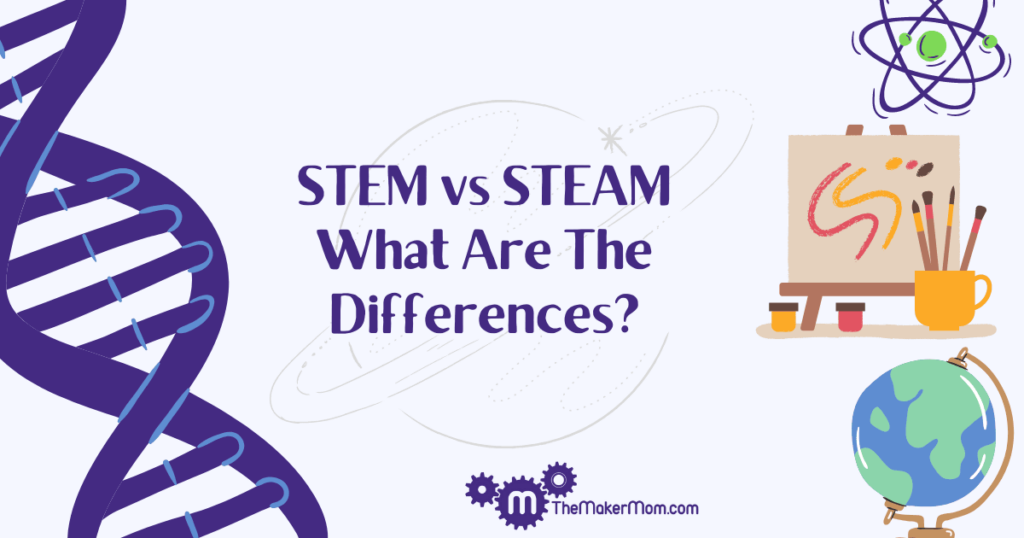STEM (Science, Technology, Engineering, and Math) has become a major focus in early education, high school, and college studies.
However, there is an expanded version of this curriculum that also includes arts. STEAM, which stands for the same subjects but adds “art” in it incorporates soft skills into the hard sciences to create a more complete and rounded course of study.
Here we dive deeper into the two programs and discuss what they are, what the major differences are, and why both play an important role in education for students.

What is STEM?
STEM is an educational curriculum that focuses on teaching the core concepts of science, technology, engineering, and math. The primary aim of a STEM program is to position students on a track to pursue a college career and occupation in these fields.
The term STEM itself is a recent development, dating back to 2001. It was only in 2001 that the U.S. National Science Foundation consolidated the four STEM fields and came up with the term. The underlying principles have formed the basis of education for centuries and will remain crucial to our advancement as a civilization.
Educational institutions around the world have invested in the future by increasing the availability of STEM-related degrees in a wide array of fields ranging from computer engineering, biology, and nursing to robotics.
The job outlook for STEM-related fields is promising for the foreseeable future and children who excel in these classes can expect many employment opportunities immediately out of college.
STEM education utilizes the accumulated information of human history to create well-informed, lasting solutions to modern problems. When new information is presented that tests the bounds of what is possible, STEM evaluates trends and assembles likely outcomes.
It is useful to think of STEM as the discipline most concerned with proper processes to achieve optimal results.
What is STEAM?
STEAM (Science, Technology, Engineering, Arts, and Math) fuses the arts and humanities with all of the base scientific concepts that form STEM. By doing so, STEAM education creates opportunities for children to develop a host of characteristics that can serve them and the world at large.
Through the integration of arts and humanities, STEAM improves stress tolerance, increases self-awareness, and builds social skills and a sense of community with others. This can directly translate to real-life effectiveness that goes far beyond the confines of a career.
STEAM provides an emphasis on creativity in problem-solving. This flexibility proves to be invaluable in life and career and allows students to think on their feet in response to problems.
The application of creativity through STEAM often takes the form of visualization. Students learn to create visual representations of data so that they are easier to understand, this is the point where art and science combine.
STEAM should be seen as a conversation interested in achieving innovative responses to problems new and old. Infusing the arts and humanities encourages practitioners to treat studies as a dialogue with one another, between departments, and with society.
What Is The Difference Between STEM and STEAM?
The most apparent difference between these two programs is STEAM’s integration of soft skills, art, and humanities into the hard sciences offered by STEM.
STEM approaches problem-solving with data-driven, black-and-white logic, whereas STEAM attempts to add layers of context to solutions. STEAM, for instance, may encourage a collaborative effort to attack a problem from multiple angles involving the arts. STEM may choose to solve the same problem without this additional input based on precedent, which is often more efficient and precise.
STEM relies on the tried-and-true information gathered in the past to determine the present and potential future courses, whereas STEAM enforces that nuance remains possible and forms the basis of innovation. STEM is often focused on absolutes, which is certainly a strength when it comes to results-driven work where the result needs to be as close to perfect as possible.
STEAM includes the element of creativity and encourages divergent and critical thinking. STEM approaches all problems as though only one solution is possible and goes to work to achieve that end. This can make STEM education seem rigid in comparison to STEAM, but it works well in certain circumstances. In the end, they are both attempting to achieve the best results possible.
While they can both be compared, it’s important to note that we shouldn’t think of one as way better than the other. They both have their strengths and faults.
Why Both Are Important
STEM and STEAM should complement one another. On the one hand, STEM learning provides a complete basis for a child’s entire scholastic and career path. It has a strong focus on the hard sciences. Those for STEAM believe you can sometimes round out the person as a whole when you add the arts and humanities.
The best of both worlds is when the path involves a combination of STEM and STEAM, concentrating on what the individual child might prefer. Rest assured that primary schools and universities around the globe will have a variety of similar programs for students.
STEM and STEAM education are not identical but they do aim to achieve similar results as a whole. They will often achieve the same results with different approaches. Each approach has merit and is worth serious consideration.
It is important to consider each student as an individual with unlimited potential. Combining STEM and STEAM will give these individuals the greatest chance to become rounded, productive members of society that can push innovation and forward thinking.
Just as each student has a different personality, each student may find either STEM or STEAM better suited to their learning style. Self-examination and assessment are valuable to determine which is a better fit for your child.
